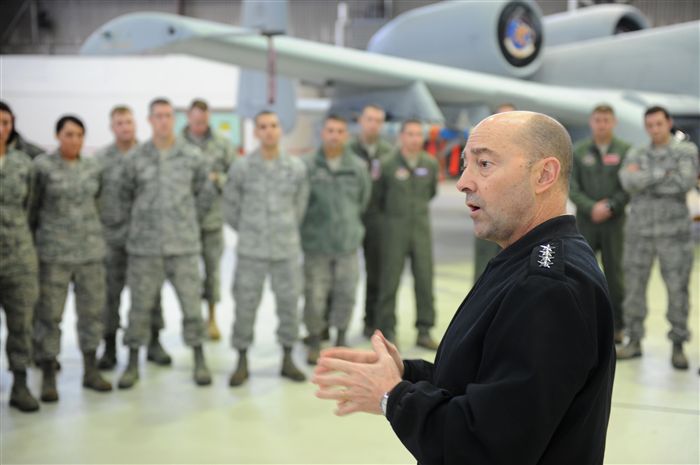
From U.S. European Command: The United States has enduring interests in supporting peace, prosperity, unity, and freedom in Europe and Eurasia as well as in bolstering the strength and vitality of NATO. As demonstrated by recent and ongoing operations, Europe remains our partner of choice in addressing current and emerging security challenges around the globe. The United States will maintain a robust, visible military presence in Europe, which will be capable of deterring and defending against aggression throughout Europe and Eurasia, and meeting our collective defense commitments under NATO’s Article 5. We will continue to enhance the NATO alliance’s readiness and interoperability and promote the strength, adaptability, security, sovereignty and territorial integrity of our allies and partners across Europe and Eurasia.
Consistent with the new NATO Strategic Concept, our force posture in Europe will evolve to meet the full range of 21st century challenges.
- We will enhance the ability of our forward presence in Europe to address ballistic missile threats with an AN/TPY-2 radar in Turkey and by forward-stationing Aegis-Ballistic Missile Defense (BMD)-capable ships in Rota, Spain, and establishing land-based SM-3 BMD sites in Romania and Poland.
- We will enhance regional special operations forces’ responsiveness by continued partnership with the NATO Special Operations Forces Headquarters.
- We will create an aviation detachment in Poland to enhance training opportunities.
We will also work with NATO allies to develop a “smart defense” approach to pool, share, and specialize capabilities.
Adapting the posture of our forces in Europe is essential to meet our collective defense commitments under NATO’s Article 5 and to address the full range of 21st century challenges. Accordingly, in addition to the enhancements identified above, the following force posture changes are planned:
U.S. Air Forces in Europe (USAFE)
- As a reduction of legacy aircraft, one Air Force A-10 squadron from Spangdahlem Air Base, Germany, has been identified for inactivation in fiscal year 2013.
- The 603rd Air Control Squadron at Aviano Air Base, Italy, will be inactivated in fiscal year 2013.
U.S. Army, Europe (USAREUR)
- Following the V Corps headquarters deployment to Operation Enduring Freedom later this year, the Army will reduce the V Corps Headquarters structure, and it will not return to Europe.
- The 7th Army/USAREUR headquarters has been transformed to include a deployable contingency command post. This command and control capability can deploy within Europe and, when augmented, can provide command and control for joint and coalition forces in small-scale operations.
- Two brigade combat teams (BCTs) identified for inactivation are the 170th BCT in fiscal year 2013 and the 172nd BCT in fiscal year 2014.
- As the U.S. Army reduces force structure, the U.S. Army in Europe will see a reduction of approximately 2,500 Soldiers from enabling units over the next five years.
- To enhance capacity and interoperability with NATO, the United States will allocate a U.S.-based heavy brigade combat team to reinvigorate its commitment to the NATO Response Force. As part of this commitment, we will also seek ways to enhance multi-national training at the world-class Joint Multinational Training Command in Grafenwöhr, Germany, in a post-ISAF environment. We will rotate a battalion-sized task force from the allocated U.S.-based heavy brigade combat team to conduct multinational training exercises on a frequency to be determined later in consultation with our allies.
- As previously announced, Baumholder remains an enduring U.S. Army, Europe community along with the Grafenwöhr/Vilseck/Hohenfels complex, Ansbach, Kaiserslautern, Wiesbaden, and Stuttgart, Germany; Vicenza, Italy; and Army communities located in the Benelux. Those locations identified as not enduring include Bamberg and Schweinfurt, which will be returned to the host nation no later than fiscal year 2015.
The Department will begin a theater-wide capacity analysis as part of a comprehensive consolidation of its overseas infrastructure in light of these force posture changes. The result could be further infrastructure adjustments. Overall, while the U.S. force posture in Europe will be smaller, it will have the capabilities and capacities necessary to support security and stability in the dynamic security environment of the 21st century. We will work together with our NATO allies, partners, and friends – and with the local communities that have made us feel at home for many years – as, together, we meet the full range of challenges confronting Europe and America.
Indeed we are, and will continue to be, STRONGER TOGETHER. (photo: Airman 1C Matthew B. Fredericks/USAF)
Image: USAF%202%2016%2012%20Stavridis%20Spangdahlem%20AB.jpg
